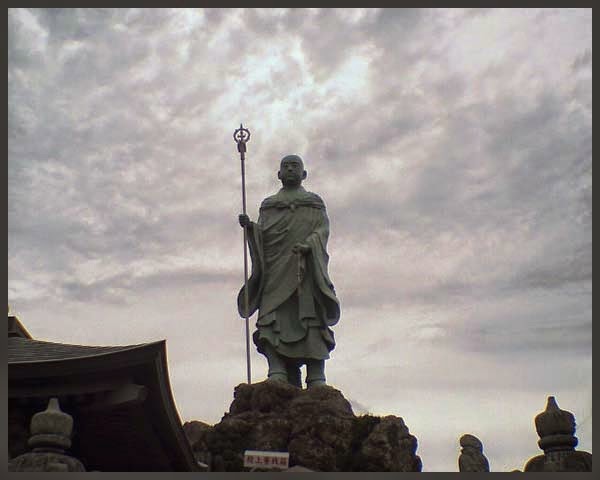[ . BACK to Daruma Museum TOP . ] ::::::::::::::::::::::::::::::::::::::::::::::::::::::::::::::::::::::::::::::::::::::::::::::::::::::::::::::::::::::::::::::::::::::::::::::::::::::::::::::::::::::::::::::
Sasaguri 篠栗四国八十八箇所 88 Henro Temples
Sasaguri Shikoku Hachijuuhachi kasho (ささぐりしこくはちじゅうはちかしょ)
篠栗霊場 Sasaguri reijo Pilgrimage to 88 sacred temples in Sasaguri, Fukuoka, Kyushu
in honor of Kobo Daishi Kukai 弘法大師 空海.
One of the
three new Henro pilgrimages in Japan.
It has been established by a monk called
慈忍 Jinin around 1835, after he completed the Henro walk in Shikoku. He wanted to give the priests, nuns and villagers, who could not travel to Shikoku, to have a chance to the benefit of a full pilgrimage. After his death, the caritable people of the village 篤志家 continued to support this project.

Kobo Daishi at Nr. 62 石原山遍照院 Henjo-In
. Kobo Daishi Reijo 弘法大師霊場 Kobo Daishi Pilgrimages in Japan . . 九州88ヶ所108霊場 Kyushu - 88 and 108 temples . Sasaguri (篠栗町 Sasaguri-machi) is a town in Kasuya District, Fukuoka.
::::::::::::::::::::::::::::::::::::::::::::::::::::::::::::::::::::::::::::::::::::::::::::::::::::::::::::::::::::::::::::::::::::::::::::::::::::::::::::::::::::::::::::::
 - source : crossroad fukuoka.jp
- source : crossroad fukuoka.jp ::::::::::::::::::::::::::::::::::::::::::::::::::::::::::::::::::::::::::::::::::::::::::::::::::::::::::::::::::::::::::::::::::::::::::::::::::::::::::::::::::::::::::::::
01 - . Nanzooin, Nanzoo-In 南蔵院 Nanzo-In, Nanzoin . .............................................................................................................................................
2 松ヶ瀬阿弥陀堂 阿弥陀如来 松ヶ瀬 - Amida Do
3 城戸釈迦堂 釈迦如来 城戸 - Shaka Do
4 金出大日堂 大日如来 金出 - Dainichi Do
5 郷ノ原地蔵堂 地蔵菩薩 郷ノ原 - Jizo Do
6 小浦薬師堂 薬師如来 小浦 - Yakushi Do
7 田ノ浦阿弥陀堂 阿弥陀如来 田ノ浦 - Amida Do
8 金剛の滝観音堂 千手観世音菩薩 山王 - Kannon Do
9 山王釈迦堂 釈迦如来 山王 - Shaka Do
10 切幡寺 千手観世音菩薩 高野山真言宗 山王 - Kannon Bosatsu
11 山手薬師堂 薬師如来 山手 - Yakushi Do
12 千鶴寺 虚空蔵菩薩 郷ノ原 - Kokuzo Bosatsu
13 城戸大日堂 十一面観世音菩薩 城戸 - Dainichi Do
14 二ノ滝寺 弥勒菩薩 高野山真言宗 中ノ河内 - Miroku Bosatsu
15 妙音寺 薬師如来 天台宗 金出 - Yakushi Nyorai
16 呑山観音寺 千手観世音菩薩 高野山真言宗 萩尾 - Kannon-Ji
17 山手薬師堂 薬師如来 山手 - Yakushi Do
18 篠栗恩山寺 薬師如来 上町 - Yakushi Nyorai
19 篠栗地蔵堂 地蔵菩薩 上町 - Jizo Do
20 中ノ河内地蔵堂 地蔵菩薩 中ノ河内 - Jizo Do
21 高田虚空蔵堂 虚空蔵菩薩 高田 - Kokuzo Do
22 桐ノ木谷薬師堂 薬師如来 桐ノ木谷 - Yakushi Do
23 山王薬師堂 薬師如来 山王 - Yakushi Do
24 中ノ河内虚空蔵堂 虚空蔵菩薩 中ノ河内 - Kokuzo Do
25 金剛山秀善寺 一願地蔵菩薩 高野山真言宗 山手 - Ichigan Jizo Bosatsu
26 薬師大寺 薬師如来 高野山真言宗 荒田 - Yakushi Dai-Ji
27 神峰寺 十一面観世音菩薩 金出 - Kannon Bosatsu
28 篠栗公園大日寺 大日如来 中町 - Dainichi Ji
29 荒田観音堂 千手観世音菩薩 荒田 - Kannon Do
30 田ノ浦斐玉堂 阿弥陀如来 田ノ浦 - Amida Nyorai
31 城戸文殊堂 文殊菩薩 城戸 - Monju Do
32 高田十一面観音堂 十一面観世音菩薩 高田 - Kannon Do
33 本明院 薬師如来 天台宗 田中 - Yakushi Nyorai
34 宝山寺 薬師如来 高野山真言宗 郷ノ原 - Yakushi Nyorai
35 珠林寺薬師堂 薬師如来 浄土宗 金出 - Yakushi Do
36 呑山天王院 波切不動明王 高野山真言宗 萩尾 -
Namikiri Fudo Myo-O 37 高田阿弥陀堂 阿弥陀如来 高田 - Amida Do
38 丸尾観音堂 千手観世音菩薩 丸尾 - Kannon Do
39 篠栗山延命寺 薬師如来 高野山真言宗 上町 - Enmei-Ji - Yakushi Nyorai
40 一ノ滝寺 薬師如来 真言宗醍醐派 山手 - Yakushi Nyorai
41 平原観音堂 十一面観世音菩薩 山王 - Kannon Do
42 中ノ河内仏木寺 大日如来 中ノ河内 - Dainichi Nyorai
43 源光山明石寺 千手観世音菩薩 真言宗大覚寺派 鳴渕 - Kannon Bosatsu
44 大宝寺 十一面観世音菩薩 高野山真言宗 金出 - Kannon Bosatsu

45 城戸ノ滝不動堂 不動明王 篠栗 -
Taki Fudo Hall 46 岡部薬師堂 薬師如来 岡部 - Okabe Yakushi Do
47 萩尾阿弥陀堂 阿弥陀如来 萩尾 - Amida Do
48 中ノ河内観音堂 十一面観世音菩薩 中ノ河内 Kannon Do
49 小松尾山雷音寺 釈迦如来 高野山真言宗 萩尾 - Shaka Nyorai
50 郷ノ原薬師堂 薬師如来 郷ノ原 - Yakushi Do
51 下町薬師堂 薬師如来 下町 - Yakushi Do
52 山手観音堂 十一面観世音菩薩 山手 - Kannon Do
53 桐ノ木谷阿弥陀堂 阿弥陀如来 桐ノ木谷 - Amida Do
54 中町延命寺 不動明王 中町 - Enmei-Ji -
Fudo Myo-o 55 桐ノ木谷大日堂 大通智勝仏 桐ノ木谷 - Dainichi Do
56 松ヶ瀬地蔵堂 地蔵菩薩 松ヶ瀬 - Jizo-Do
57 田ノ浦栄福堂 阿弥陀如来 田ノ浦 - Amida Nyorai
58 大久保観音堂 千手観世音菩薩 大久保 - Kannon Do
59 田ノ浦薬師堂 薬師如来 田ノ浦 - Yakushi Do
60 神変寺 大日如来 高野山真言宗 松ヶ瀬 - Dainichi Nyorai
61 山王寺 大日如来 真言宗御室派 山王 - Dainichi Nyorai
62 石原山遍照院 十一面観世音菩薩 - Henjo-In
63 天狗岩山吉祥寺 毘沙門天 天狗岩 - Bishamon Ten
64 荒田阿弥陀堂 阿弥陀如来 荒田 - Amida Do
65 三角寺 十一面観世音菩薩 高野山真言宗 御田原 - Kannon Bosatsu
66 観音坂観音堂 千手観世音菩薩 金出 - Kannon Do
67 山王薬師堂 薬師如来 山王 - Yakushi Do
68 岡部神恵院 阿弥陀如来 山王 - Amida Nyorai
69 高田観音堂 聖観世音菩薩 高田 - Kannon Do
70 五塔の滝 馬頭観世音菩薩 鳴渕 - Bato Kannon
71 城戸千手観音堂 千手観世音菩薩 城戸 - Kannon Do
72 田ノ浦拝師堂 大日如来 田ノ浦 - Haishi Do - Dainichi Nyorai
73 山王釈迦堂 釈迦如来 山王 - Shaka Do
74 城戸薬師堂 薬師如来 城戸 - Yakushi Do
75 紅葉ヶ谷薬師堂 薬師如来 郷ノ原 - Yakushi Do
(75) 善通寺 薬師如来 単立 荒田 - Zentsu-Ji - Yakushi Nyorai
76 萩尾薬師堂 薬師如来 萩尾 - Yakushi Do
77 山王薬師堂 薬師如来 山王 - Yakushi Do
78 山手阿弥陀堂 阿弥陀如来 山手 - Amida Do
79 補陀洛寺 十一面観世音菩薩 高野山真言宗 下町 - Fudaraku-Ji - Kannon
80 田ノ浦観音堂 千手観世音菩薩 田ノ浦 - Kannon Do
81 二瀬川観音堂 千手観世音菩薩 二瀬川 - Kannon Do
82 鳥越観音堂 千手観世音菩薩 鳴渕 - Kannon Do
83 千手院 聖観世音菩薩 高野山真言宗 御田原 - Kannon Bosatsu
84 中町屋島寺 十一千手面観世音菩薩 中町 - Kannon Bosatsu
85 祖聖大寺 聖観世音菩薩 高野山真言宗 郷ノ原 - Kannon BOsatsu
86 金出観音堂 十一面観世音菩薩 金出 - Kannon Do
87 弘照院 聖観世音菩薩 高野山真言宗 金出 - Kannon Bosatsu
88 大久保薬師堂 薬師如来 Okubo Yakushi-Do

::::::::::::::::::::::::::::::::::::::::::::::::::::::::::::::::::::::::::::::::::::::::::::::::::::::::::::::::::::::::::::::::::::::::::::::::::::::::::::::::::::::::::::::
- quote - 篠栗霊場の歴史は天保年間、慈忍という人物がこの地を訪れた天保六年に始まる。慈忍は四国八十八箇所を巡拝したその帰りに篠栗村に立ち寄った尼僧であった。四国八十八箇所の開祖たる弘法大師も訪れたと伝わるこの村の者達の困窮を垣間見た慈忍は、その救済を目論みこの地にとどまり弘法大師の名において祈願を続け、やがて村に安寧をもたらしたものと伝わる。このことを弘法大師の利益(りやく)であるとした慈忍は、村の者達に四国のそれを模した88か所の霊場の造成を提案。呼応した村人達の手によって徐々に石仏がつくられはじめ、慈忍が没したのちにおいて、その志を継ぐ村の篤志家達の尽力によって88に達する霊場群が完成、それが今にある篠栗霊場の起源であると伝わっている。なお、明治期、成立した霊場会に対し、一部の寺院が土地建物を買収し、本来の札所とは一部異なる、との批判もある。 - source : wikipedia - Sasaguri Sightseeing Spots - - source : town.sasaguri.fukuoka.jp ::::::::::::::::::::::::::::::::::::::::::::::::::::::::::::::::::::::::::::::::::::::::::::::::::::::::::::::::::::::::::::::::::::::::::::::::::::::::::::::::::::::::::::::
sasaguri ささ栗(ささぐり)chestnut sweet sasame sasaguri さゝめさゝ栗 from Gifu, Nakatsugawa town
 . sweet chestnut (kuri 栗) .
. sweet chestnut (kuri 栗) . ::::::::::::::::::::::::::::::::::::::::::::::::::::::::::::::::::::::::::::::::::::::::::::::::::::::::::::::::::::::::::::::::::::::::::::::::::::::::::::::::::::::::::::::
. Kobo Daishi, Kukai 弘法大師 空海 . (774-835) . Kobo Daishi Reijo 弘法大師霊場 Kobo Daishi Pilgrimages in Japan . .......................................................................
. Fudō Myō-ō, Fudoo Myoo-Oo 不動明王 Fudo Myo-O
Acala Vidyârâja – Vidyaraja – Fudo Myoo . . Pilgrimages to Fudo Temples 不動明王巡礼
Fudo Myo-O Junrei - Introduction . - #sasagurihenro #sasaguriintroduction - ::::::::::::::::::::::::::::::::::::::::::::::::::::::::::::::::::::::::::::::::::::::::::::::::::::::::::::::::::::::::::::::::::::::::::::::::::::::::::::::::::::::::::::::
. O-Mamori お守り Amulets and talismans from Japan . . Japanese Temples - ABC list - . [ . BACK to WORLDKIGO . TOP . ] [ . BACK to DARUMA MUSEUM TOP . ] ::::::::::::::::::::::::::::::::::::::::::::::::::::::::::::::::::::::::::::::::::::::::::::::::::::::::::::::::::::::::::::::::::::::::::::::::::::::::::::::::::::::::::::::
--
Posted By Gabi Greve to
Gokuraku - Jigoku on 2/10/2015 05:28:00 am
























































